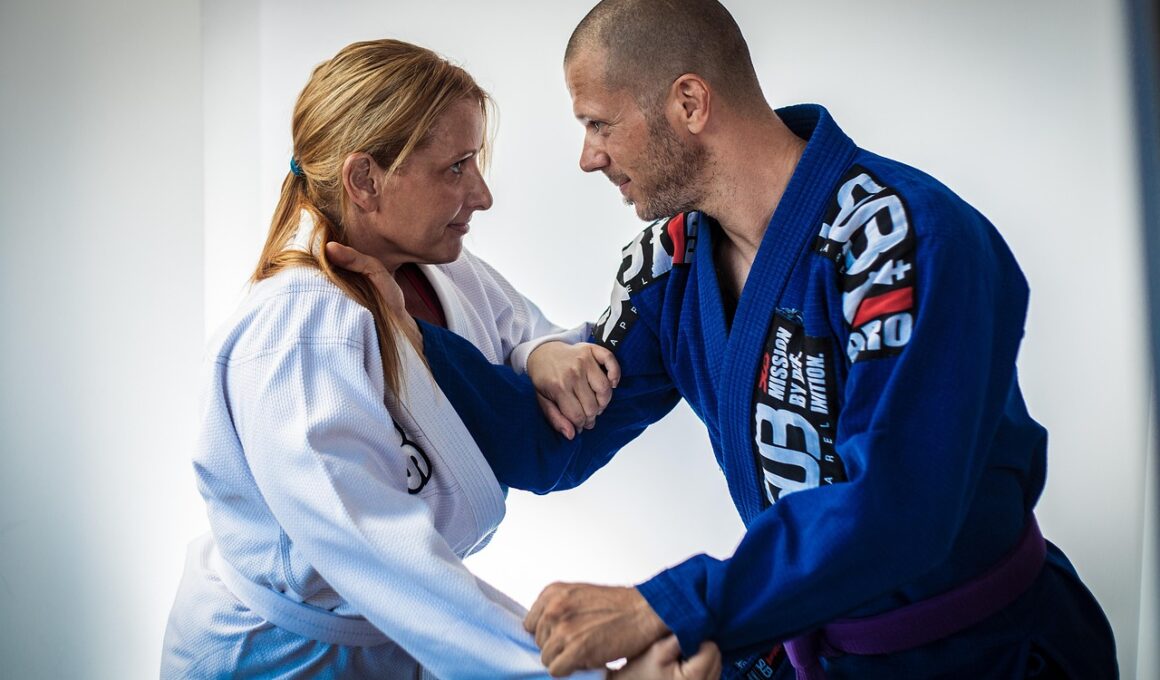The Science Behind Historical Grappling Techniques
The study of historical grappling techniques reveals profound insights into the art of self-defense. Grappling, often viewed simply as a physical engagement, encompasses a wide spectrum of strategies, philosophies, and historical contexts. Early practitioners understood the importance of body mechanics and leverage, allowing them to overcome larger or stronger opponents. This understanding is enhanced when coupled with anatomical knowledge and the physics of movement. Many ancient fighting systems, from the Japanese jiu-jitsu to the European wrestling styles, incorporated these elements. Practitioners stressed the significance of balance, timing, and awareness in successful application. Each technique was optimized over centuries through trial and error, creating an efficiency that modern practitioners can still apply today. Additionally, grappling arts served social and cultural purposes, acting as forms of physical expression and community bonding. As research continues, new insights emerge, highlighting how effective these systems remain in contemporary settings. Exploring different historical contexts enriches our understanding, showcasing the diverse backgrounds from which these techniques arose. In this exploration, grappling emerges not just as a combat method but as a reflection of human ingenuity and adaptability, forming the basis for today’s self-defense training.
Understanding the Historical Context
The historical context of grappling techniques offers a glimpse into the evolution of self-defense systems. Grappling has roots in countless cultures, resulting in unique adaptations of combat. For instance, the ancient Greeks practiced Pankration, blending striking and grappling elements. Similarly, China offered various wrestling styles, each developed according to regional needs and philosophies. The incorporation of local traditions shaped effective techniques over generations. Furthermore, many grappling arts served specific combat scenarios, be it battlefield conditions or self-defense in civilian settings. Techniques were meticulously recorded; treatises from ancient masters, such as the *Flos Duellatorum* by Fiore dei Liberi, provide a robust foundation for studying these arts. These manuals offer intricate details on movements, counters, and strategies, showcasing historical relevance beyond mere fighting skills. Likewise, connections to philosophical teachings often emerged, emphasizing the importance of discipline and respect. As globalization increases today, integrating these diverse historical perspectives enriched modern self-defense training. Grappling also serves as a lens through which cultural values and societal norms committed to preserving essential social order are observed. Thus, its study goes beyond physicality and engages elements of anthropology and history alongside combat mechanics.
The mechanics of grappling align closely with principles from physics and body movement. Understanding how body weight, leverage, and momentum interact is crucial in executing effective techniques. For instance, grapplers learn to use their opponent’s weight against them, a strategy rooted in principles of balance and force. This involves understanding the center of mass and how to manipulate it during a confrontation. Practical applications in self-defense environments have shown that skilled grapplers can control their surroundings with minimal energy expenditure. Moreover, training routines in various historical grappling disciplines prioritize muscle memory, allowing techniques to be executed instinctively under stress. The integration of drills into a practitioner’s regimen reinforces these principles, maximizing efficiency. Historically, many techniques emerged from a need to address common combat challenges, demonstrating their practicality. Defensive grappling systems, like those in judo, leverage the opponent’s movements, allowing for seamless transitions and effective counters. Furthermore, the exploration of historical grappling techniques highlights adaptability, as practitioners adjust to different environments or opponents. Therefore, incorporating scientific principles of movement can enhance training efficacy, proving beneficial for both modern practitioners and historical studies.
The Role of Psychological Factors
In grappling, psychological elements significantly contribute to performance and effectiveness. Understanding one’s mindset plays an essential role in how techniques are applied. Historical grapplers were not only trained physically; they cultivated mental fortitude capable of withstanding the pressures of combat. The psychological landscape encompasses aspects such as focus, anxiety management, and resilience. Many historical texts suggest that grapplers must be aware of their emotions and reactions in high-stress environments. For instance, a calm demeanor can provide a strategic advantage during a confrontation. Anxiety may impede reflexes and decision-making, which are vital during grappling exchanges. Furthermore, confidence stemming from thorough training programs enhances performance, enabling practitioners to execute complex techniques effectively. Competitive environments, too, have historically been avenues for psychological growth, shaping individuals through challenges and experiences. Emphasis on understanding the opponent’s mindset emerged in various grappling contexts, encouraging practitioners to anticipate movements and reactions to better counter. In today’s world, this knowledge translates into effective self-defense training methodologies, where mental preparation complements physical training. Thus, awareness of psychological factors presents a holistic approach to grappling and self-defense, bridging the gap between mind and body.
The influence of cultural exchange has greatly shaped grappling techniques throughout history. As civilizations interacted, techniques were shared, adapted, and restructured, resulting in hybrid systems that reflected diverse backgrounds. For example, during the era of the Silk Road, merchants and travelers disseminated martial philosophies, leading to enhancements in grappling arts. Techniques that emerged from these interactions often incorporated varied strategies, optimizing effectiveness across different combat situations. The evolution of Brazilian jiu-jitsu can be traced back to the adaptation of traditional Japanese jiu-jitsu techniques, further illustrating globalization’s impact on these systems. As people migrated, they carried their skills and knowledge, allowing grappling techniques to evolve in new contexts. Additionally, formal competitions like *Vale Tudo* showcased an amalgamation of styles and techniques, leading to innovations in modern self-defense training. Cross-cultural influences often emphasize fundamental principles such as humility, respect, and perseverance. By examining these cultural contributions, one can appreciate grappling arts as not merely technical knowledge but as a shared human heritage, encompassing lessons learned across generations. Thus, exploring grappling within its cultural context enriches its practice and strengthens its foundation in modern self-defense training.
Contemporary Applications of Historical Techniques
Today’s self-defense training frequently integrates historical grappling techniques, underscoring their relevance to contemporary issues. Many practitioners find value in applying these time-honored techniques to modern-day conflicts and scenarios. The adaptation largely stems from the effectiveness of historical principles that address current needs. For instance, Brazilian jiu-jitsu, with its emphasis on leverage and ground control, remains popular for self-defense situations. Judo has also found a place in law enforcement and military training due to its versatility and effectiveness against larger aggressors. Combat sports, entrenched in historical grappling roots, continue to thrive, adapting while maintaining relevance. Moreover, the growing awareness of personal safety in urban environments highlights the importance of effective grappling techniques. Many training programs emphasize situational awareness alongside physical skills, acknowledging that prevention is crucial. Additionally, the distilled teachings from historical textbooks serve well as theoretical foundations for modern practitioners. The understanding of biomechanics and psychological readiness enhances the overall training experience. Therefore, contemporary self-defense systems draw heavily from historical grappling techniques and philosophies, creating a future informed by innovative approaches built upon rich traditions that continue to resonate.
The journey to mastering grappling techniques can be both fulfilling and complex. The continuous evolution of self-defense methodologies requires a comprehensive understanding of both historical context and modern application. Students often engage in extensive practice, focusing on perfecting techniques and application strategies. Importantly, grappling training promotes physical fitness, cultivating strength, flexibility, and coordination. This physicality forms the crux of effective self-defense systems while enhancing mental acuity. Moreover, as grappling techniques have developed, they provide practitioners with a myriad of skills applicable beyond self-defense. The disciplines encourage critical thinking, adaptability, and perseverance, proven valuable in various life aspects. Tournaments and competitions present opportunities for practical application and progression, fostering growth and camaraderie among practitioners. Historical studies encourage deeper reflection on the origins of specific techniques, allowing grapplers to establish a meaningful connection to the past. Understanding the cultural significance of each style enriches the learning experience and promotes respect for traditions. As students navigate skills, they gradually develop an identity within a broader historical framework. This interconnectedness leads to insights that enhance overall comprehension of the self-defense continuum. Thus, grappling transcends physical confrontation, becoming a pathway to personal development and self-discovery.
In conclusion, grappling techniques embody a rich tapestry of historical significance, cultural exchange, and scientific principles. Their practical applications remain relevant in contemporary self-defense training, showcasing the staying power of these techniques. The evolution of grappling has yielded invaluable knowledge applicable across various settings, from personal safety to competitive sports. The integration of historical perspectives fosters an understanding that transcends mere combat practice. As grappling arts continue to thrive, practitioners are empowered to navigate complexities of human interactions, cultivating essential skills. Ultimately, embracing the historical underpinnings of grappling nurtures a deeper appreciation for self-defense systems, reinforcing a sense of community and shared heritage. Therefore, this exploration of the science behind historical grappling techniques highlights the relevance of their study, forging connections between past, present, and future within the self-defense continuum. Such reflection unveils the art’s continued importance as a conduit for resilience, confidence, and personal growth amidst evolving societal challenges. As practitioners engage with historical grappling traditions, they pave the way for a future enriched by shared wisdom and contemporary applications. The journey of grappling continues, reminding us of its foundational role in understanding self-defense training and human experience.


